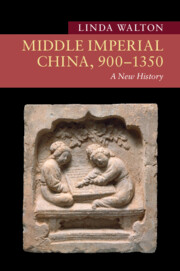Book contents
- Middle Imperial China, 900–1350
- New Approaches to Asian History
- Middle Imperial China, 900–1350
- Copyright page
- Dedication
- Contents
- Figures
- Maps
- Acknowledgments
- Introduction
- 1 The Turbulent Tenth Century
- 2 Song in a Multipolar World
- 3 Schooling, State, and Society in Song and Jin
- 4 An Economic Revolution?
- 5 Cities and Urban Life
- 6 Religious Transformations
- 7 Ways of Knowing
- 8 The Arts of Culture
- 9 Gendered and Generational Lives
- 10 Mapping the Built and Natural Environment
- 11 Sustaining Life and Healing Bodies
- 12 The Mongol Yuan Dynasty in China
- 13 Yuan China in the Mongol Eurasian Empire
- Bibliography
- Index
- New Approaches to Asian History
11 - Sustaining Life and Healing Bodies
Food and Medicine
Published online by Cambridge University Press: 20 July 2023
- Middle Imperial China, 900–1350
- New Approaches to Asian History
- Middle Imperial China, 900–1350
- Copyright page
- Dedication
- Contents
- Figures
- Maps
- Acknowledgments
- Introduction
- 1 The Turbulent Tenth Century
- 2 Song in a Multipolar World
- 3 Schooling, State, and Society in Song and Jin
- 4 An Economic Revolution?
- 5 Cities and Urban Life
- 6 Religious Transformations
- 7 Ways of Knowing
- 8 The Arts of Culture
- 9 Gendered and Generational Lives
- 10 Mapping the Built and Natural Environment
- 11 Sustaining Life and Healing Bodies
- 12 The Mongol Yuan Dynasty in China
- 13 Yuan China in the Mongol Eurasian Empire
- Bibliography
- Index
- New Approaches to Asian History
Summary
The tenth to thirteenth centuries were formative in the creation of what we now know as Chinese cuisine, including its rich regional diversity. The foods that people in the Song, Liao, and Jin ate were dependent on what the natural environment provided or what could be acquired through trade. But food and drink were also products of cultural preferences that evolved over time and came to identify economic, social, and ethnic difference. Song, Khitan, and Jurchen foodways differed significantly, rooted in the experiences of steppe and agrarian life as well as the diversity of cultures. People encountered unfamiliar food and drink in the cities andthrough diplomatic and commercial exchanges between Song and its neighbors. The food and drink people consumed were also deeply tied to the theory and practice of Chinese medicine, which reached new levels of standardization and sophistication during the Song and Jin. How were medical traditions transmitted through texts and teachers? How did the state promote and regulate medical knowledge and practice? The spread of printing and commercial publishing made information about food and medicine more widely available to the literate, and others could gain access to this knowledge through oral and visual transmission.
- Type
- Chapter
- Information
- Middle Imperial China, 900–1350A New History, pp. 269 - 293Publisher: Cambridge University PressPrint publication year: 2023



